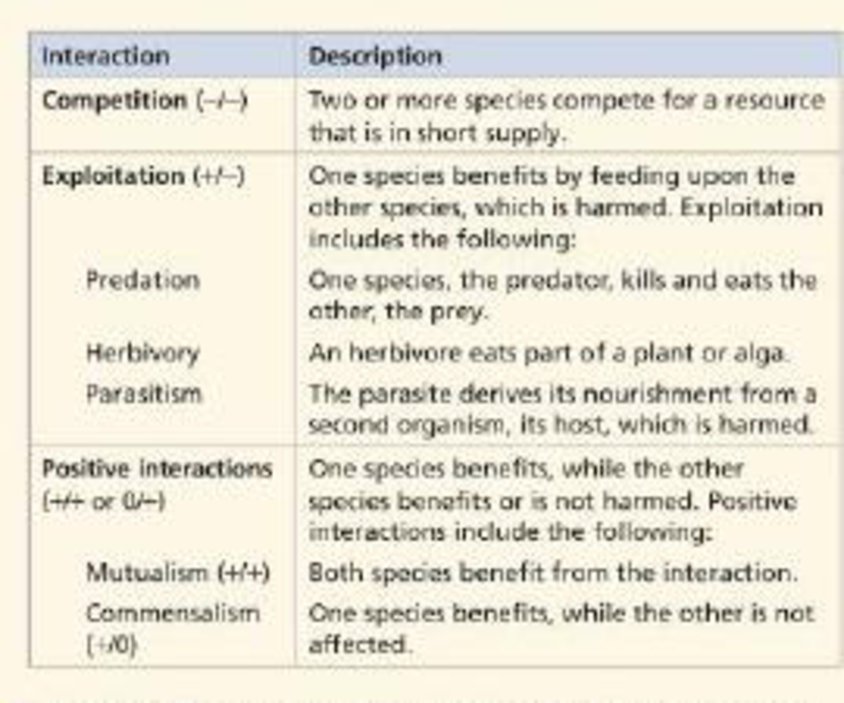
Concept explainers
Interspecific interactions affect the survival and reproduction of the species that engage in them. As shown in the table, these interactions can he grouped into three broad categories: competition, exploitation, and positive interactions.

Competitive exclusion states that two species competing for the same
For each interaction listed in the table, give an example of a pair of species that exhibit the interaction.
To provide: Examples of species involved in different types of interspecific interactions.
Concept introduction: Interspecific interactions refer to the relationship that exists between members of different species of a biological community. It includes commensalism, parasitism, herbivory, predation, competition, and others. These interactions can have either positive or negative impact on the survival of species engaged in the interaction.
Given data: Refer to the table in the concept 54.1 “ Community interactions are classified by whether they help, harm, or have no effect on the species involved”, in the textbook.
Explanation of Solution
The interspecific interactions can be classified into three categories, namely, positive interactions, competition and exploitation.
The positive interaction is a type of interaction in which one species are benefitted and the other may or may not get benefits but is never harmed.
The competition is a type of engagement where both the species are affected (harmed) as they share a common resource (short in supply).
In exploitation, one species get benefit while the other is affected negatively (harmed).
The positive interactions include mutualism and commensalism. On the contrary, exploitation involves predation, parasitism and herbivory.
Interactions along with its examples are tabulated as follows:
| Type of interactions | Examples |
| Competition | Lynx and foxes of Alaska (compete for snowshoe hares) |
| Exploitation | |
| Predation | Lion (predator) and antelope (prey) |
| Herbivory | Rice grasshopper (herbivore) and rice plant (act as food) |
| Parasitism | Plasmodium(parasite) and human (host) |
| Positive interactions | |
| Mutualism | Acacia and ant (both benefit each other) |
| Commensalism | Cattle egrets (get a benefit)and African buffalo (not harmed) |
Want to see more full solutions like this?
Chapter 54 Solutions
Campbell Biology
- How is a protein destined for the Endoplasmic Reticulum (ER), imported into the ER? Be concise.arrow_forwardFind out about the organisations and the movements aimed at the conservation of our natural resources. Eg Chipko movement and Greenpeace. Make a project report on such an organisation.arrow_forwardWhat are biofertilizers and mention the significancearrow_forward
- PCBs and River Otters: Otters in Washington State’s Green-Duwamish River have high levels of polychlorinated biphenyls (PCBs) in their livers. PCBs can bind to the estrogen receptors in animals and disrupt the endocrine system of these otters. The PCBs seem to increase the estrogen to androgen ratio, skewing the ratio toward too much estrogen. How would increased estrogen affect the river otter population? Based on your reading of the materials in this unit, what factors can affect fertility in humans? Explain how each of the factors affecting human fertility that you described can disrupt the human endocrine system to affect reproduction.arrow_forwardOther than oil and alcohol, are there other liquids you could compare to water (that are liquid at room temperature)? How is water unique compared to these other liquids? What follow-up experiment would you like to do, and how would you relate it to your life?arrow_forwardSelection of Traits What adaptations do scavengers have for locating and feeding on prey? What adaptations do predators have for capturing and consuming prey?arrow_forward
- Competition Between Species What natural processes limit populations from growing too large? What are some resources organisms can compete over in their natural habitat?arrow_forwardSpecies Interactions Explain how predators, prey and scavengers interact. Explain whether predators and scavengers are necessary or beneficial for an ecosystem.arrow_forwardmagine that you are conducting research on fruit type and seed dispersal. You submitted a paper to a peer-reviewed journal that addresses the factors that impact fruit type and seed dispersal mechanisms in plants of Central America. The editor of the journal communicates that your paper may be published if you make ‘minor revisions’ to the document. Describe two characteristics that you would expect in seeds that are dispersed by the wind. Contrast this with what you would expect for seeds that are gathered, buried or eaten by animals, and explain why they are different. (Editor’s note: Providing this information in your discussion will help readers to consider the significance of the research).arrow_forward
 Biology Today and Tomorrow without Physiology (Mi...BiologyISBN:9781305117396Author:Cecie Starr, Christine Evers, Lisa StarrPublisher:Cengage Learning
Biology Today and Tomorrow without Physiology (Mi...BiologyISBN:9781305117396Author:Cecie Starr, Christine Evers, Lisa StarrPublisher:Cengage Learning Biology (MindTap Course List)BiologyISBN:9781337392938Author:Eldra Solomon, Charles Martin, Diana W. Martin, Linda R. BergPublisher:Cengage Learning
Biology (MindTap Course List)BiologyISBN:9781337392938Author:Eldra Solomon, Charles Martin, Diana W. Martin, Linda R. BergPublisher:Cengage Learning Concepts of BiologyBiologyISBN:9781938168116Author:Samantha Fowler, Rebecca Roush, James WisePublisher:OpenStax College
Concepts of BiologyBiologyISBN:9781938168116Author:Samantha Fowler, Rebecca Roush, James WisePublisher:OpenStax College





